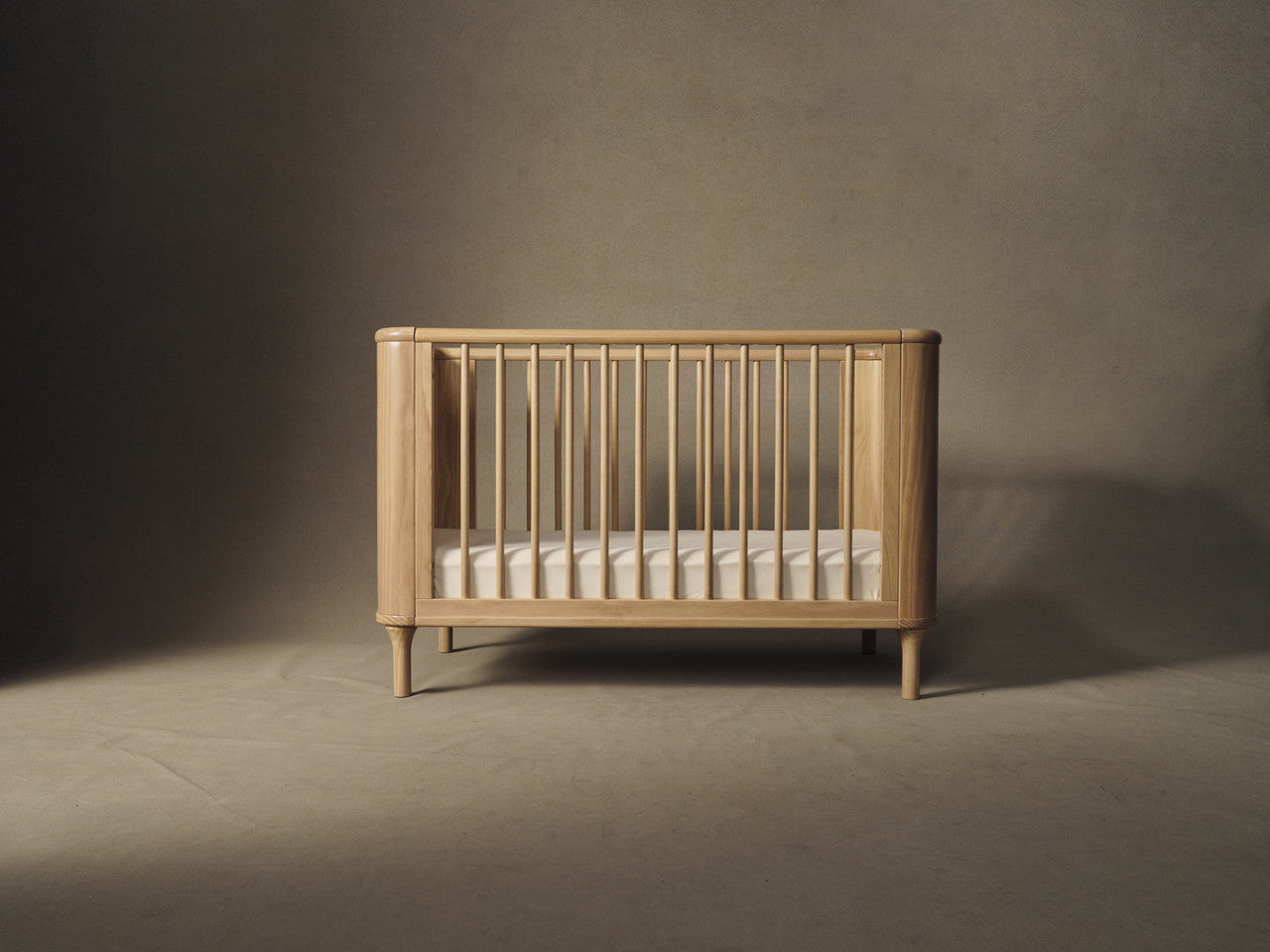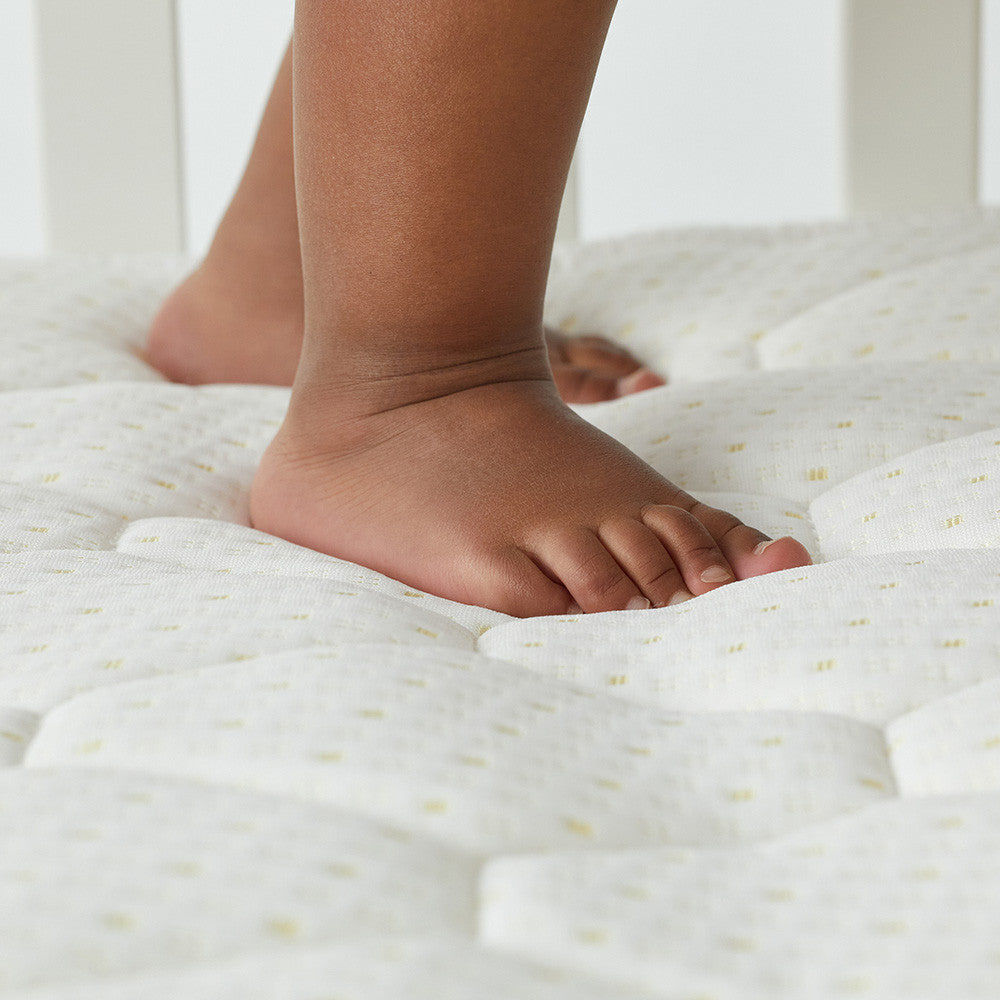No matter what you try, sometimes it just seems impossible to get your little one to fall asleep in their cot.
This is a very common experience shared around the world by parents, and there are some easy steps you can take to help make the adjustment from your arms to the cot a lot smoother, and ensure that some quieter nights are ahead going forward.
Why Will My Baby Only Go to Sleep in My Arms?
At the core, your baby loves anything that makes them feel comfortable.
There aren’t many things more comfortable than the warm embrace of your arms, and it creates an environment that is very similar to that of the womb.
There is a stark contrast between the familiar and subtle movement that comes from being held, compared to the still, quiet and colder cot.
At the core of this behaviour is biology. Being close to their caregiver not only helps to regulate an infant’s breathing, but also their heart rate and temperature.
We know how cute your baby is, and how lovely it is to hold them as close to you as possible, as often as you can.
However, it is important to keep in mind that if you hold your baby too often and for too long, your baby will associate sleep only with that setting, and the adjustment to the cot will be more complicated.
It is important to find the right balance with your newborn, so you can ensure the transition is as smooth as possible.
Why Do Newborns Struggle to Sleep in a Cot?
Infants struggle to sleep in a cot because it is a stark contrast to the experience of being in the womb.
For the majority of their short life, they have been so used to falling asleep with constant subtle motion, a high level of warmth, tight spaces, and the soothing rhythm of your heartbeat and voice.
A cot, no matter how comfortable, can feel cold and unfamiliar, especially when it’s initially being introduced to your baby.
Infants will often startle themselves awake due to natural reflexes, and while getting used to sleeping on their backs, this can frequently happen, especially in a quiet environment.
Separation anxiety - while we all experience it to a certain extent - babies have high levels of it.
Babies, especially in the early weeks, can sense when their parents aren’t close by, and this absence of familiar contact, smell and warmth can cause distress.
This segues nicely into the irregular sleep cycles newborn babies have, which are often short and when they wake and can’t feel the presence of their caregivers, it can be harder to settle them back down between cycles.
However, you must trust the process. It’s just a matter of time before your baby will adjust to life outside the womb, as long as you make sure you establish a strong and consistent routine, your baby will soon be right at home in their cot.
Essential Steps for Getting Your Baby to Fall Asleep in Their Cot
The key to establishing a strong sleeping routine for your young one is all about patience, consistency, and repetition.
At Tasman Eco, we believe these are the essential steps in making sure both your little one and you get a good night's sleep.
- Create and Nurture a Consistent Bedtime Routine: This is one of the most crucial steps in being able to get your baby to sleep soundly in their cot. A calming, predictable and repetitive routine will ensure your baby begins to realise what bedtime looks like and when it’s time to begin to wind down.
- Get that Sleep Schedule Set: Similar to the first step, putting your little one to bed at the same time every night will allow them to learn to fall asleep on their own. It is ideal to put your baby to bed when they’re drowsy and not completely asleep, as it ensures a smoother transition to snoozing.
- Set the Room Up Well: Take your baby into a room that is dark and quiet. White noise can be an especially useful tool if your little one is sensitive to the sounds of outside noises. Lie them down onto their back and ensure the cot is safe and comfortable, and remove any pillows, blankets or toys.
- Soft Touch and Rhythm: Patting your baby’s chest in a slow heartbeat rhythm can help transition them to dreamland. Do this for around two to three minutes. If they are still restless, pick them and cuddle them for a minute or two and then repeat the process again.
- Stay Vigilant: It is important to avoid any sleep crutches and stay vigilant in the process. The less you rock, feed, or hold your baby to sleep, the more quickly they will become independent when it comes to their sleep.
Practice Makes Perfect in Your Bedtime Process
Following the same process every time you put your young one to sleep will set you up for success.
As the routine becomes familiar and comforting, it will make it easier for your baby to settle in their cot.
Familiarity is key to helping your baby feel secure and reducing distress and resistance over time.
As they grow used to the process, you can gradually reduce the amount of patting or settling you need to do.
Babies are incredibly malleable, but need consistency to understand and learn what’s expected of them.
Constantly changing the way you settle them can create confusion and prolong the time it takes for them to learn to fall asleep independently.
By staying calm, consistent, and committing to a settling process each day, you give your baby the best chance to sleep soundly, and maybe you’ll actually be able to as well.
How Long Will It Take for My Baby to Adjust to a Cot?
As stated previously, patience and consistency are key to setting your baby up for success when it comes to their sleep development.
So, how long can you expect it to take for your baby to adjust to a cot?
This adjustment period, in most cases, takes around one to two weeks for infants to get used to their new sleeping environment.
A lot of factors are at play in this circumstance, though, with temperament, age, and already established sleep patterns playing a big role.
The establishment of a calming bedtime routine, placing your baby in the cot drowsy but still awake, will encourage independent sleep habits, which is essential.
While some babies adjust quickly, others may resist at first. Be patient and gentle; with time and routine, most babies will naturally learn to sleep comfortably in their cot.
Common Mistakes Parents Make in Getting Their Baby to Sleep
Many well-meaning parents make common mistakes when creating a pattern of sleep behaviour for their young one, which ends up making the transition harder than it needs to be overall.
- The Inconsistency of Your Sleep Routine: The key to a strong sleep schedule for both your young one and yourself is consistency. Babies thrive on routine. Consistently changing routines, or trying new tactics can confuse your baby and what’s expected of them, which can continue to cause disrupted sleep and stunt your progress in getting them used to their cot and bedtime in general. A consistent bedtime routine is essential for establishing normalcy.
- Lengthy Daytime Naps and Overstimulation: Limiting lengthy daytime naps helps your baby build enough sleep pressure to fall asleep more easily at night. Too much daytime sleep can lead to delayed bedtimes, night wakings and confusion about sleep routines. Regulating daytime naps supports your baby’s internal clock and makes settling in their cot at bedtime smoother.
- Avoid Putting Your Baby Down Fully Asleep: One of the biggest mistakes you can make in getting your baby to fall asleep soundly in their cot is putting them in bed when they’re already fully asleep. This can cause them to wake up startled in an environment that doesn’t feel familiar. Instead, the optimal setting is to put your baby to bed when they are drowsy but still awake. This is easier said then done and takes time to get it working.
- Overusing Sleep Props: An overreliance on rocking, feeding, or holding your baby to get them to sleep can create strong sleep associations, and can be negative when it comes to fostering independent sleeping behaviour.
- Rushing the Process: Babies will often make a fuss before falling asleep. This is natural, and too often parents will rush to pick them up to comfort them. This act prevents them from learning to self-soothe. This is a vital learning step for cot sleep success.
- Uncomfortable Sleep Environment: You have to set yourself and your baby up for success. A noisy, bright, or too-cold room can interfere with your newborn’s sleeping ability. Ensure you create a space that is quiet, dim, and at a comfortable temperature. White noise can be very helpful, and a firm, safe mattress is essential.
Acknowledging these steps and mistakes can go a long way in how quickly it takes for your baby to feel secure and be fuss-free in their sleeping kingdom.
When Should You Stop Using a Cot?
There is no one-size-fits-all approach to this question, and it comes down to the individual toddler.
On average, most toddlers transition from a cot to a bed between the ages of 18 months and 3 years old.
The right time depends on your baby’s development, safety, and sleep habits.
Some indications that may show it’s time to upgrade to a bed include:
- Climbing Out of the Cot: First off, it’s a safety risk for the child if they start to climb out of their cot, and it’s clear that a bed may make more sense for them.
- Outgrowing the Cost: The majority of cots have a weight or height limit (usually around 90 cm or 15kg). If your child is getting too big, it’s time to transition.
- Potty Training Progress: If your young one is beginning to toilet train, and needs easy access to the bathroom at night, moving from a cot to a bed helps to support them in their independence journey.
- Disrupted Sleep or Resistance: If your child suddenly begins to resist the cot after being previously very comfortable with it, they may be ready for a more grown-up sleeping set-up.
The upgrade process can be a very exciting one for your infant. Celebrate the transition, keep similar sleeping patterns and enjoy watching your child take the next step in their sleeping journey.
How We Can Help at Tasman Eco
Tasman Eco is one of Australia’s leading suppliers of nursery furniture and mattresses. What began as a family business has continued to grow within the family, a wonderful team and beyond.
We have been in the industry for more than 30 years. This experience and expertise have helped more than one million Australian parents with their own families, and we are excited for many more Australians to start their parenting journeys with us at Tasman Eco.
Explore our full range of nursery furniture, and let’s give your little one the dream sleep they deserve.







Share:
Comprehensive Baby Led Weaning Guide
Are Cot Bumpers Safe?